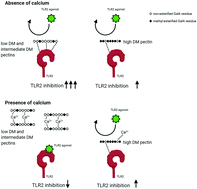The influence of calcium on pectin's impact on TLR2 signalling
Abstract
High intake of dietary fibres and calcium has been correlated to a lower frequency of Western disease such as allergy, asthma and obesity. How the combined higher intake of dietary fibres and calcium reduces the incidence of these diseases is unknown. Dietary fibre pectin can interact with Toll-like receptor (TLR) 2 and calcium in a degree of methyl-esterification (DM)-dependent manner. Low DM pectins interact stronger with TLR2 than high DM pectins. Since low DM pectin are known to bind calcium strongly, we investigated how calcium influences the DM-dependent impact of pectins on TLR2 signalling. We tested TLR2 activating, inhibiting and binding properties of pectins with DM18, DM52 and DM69 under 0 mM, 1 mM and 10 mM calcium conditions. None of the pectins activated TLR2, but pectins inhibited TLR2. Under 0 mM calcium conditions, especially DM18 and DM52 strongly inhibited TLR2 and bound strongly to TLR2. Addition of 1 and 10 mM calcium to these pectins reduced TLR2 inhibition and TLR2 binding. Our study shows that calcium reduces inhibition of TLR2 by low and intermediate DM pectins, but calcium has lower impact on TLR2 inhibition by high DM pectins. Calcium may therefore beneficially influence the impact of pectin on TLR2 signalling and contribute to an improved intestinal barrier function. A combined higher intake of pectin and calcium may therefore contribute to a lower incidence of Western diseases.



 Please wait while we load your content...
Please wait while we load your content...